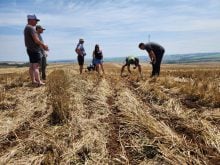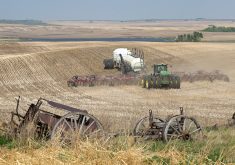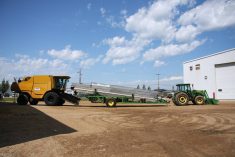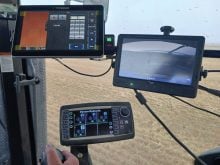The next federal-provincial-territorial agriculture policy framework must make digital agriculture a priority, according to the Canadian Agricultural Policy Institute and Manitoban tech accelerator EMILI.
A joint report, released by the think-tank and non-profit last month, says a new focus on digital farm technology is key to strengthening Canadian farms amid trade, economic and climate challenges.
“Digital agriculture offers powerful tools to address Canada’s pressing agricultural challenges, but the current approach isn’t delivering results,” the report reads.
Read Also

Trump’s tariffs take their toll on U.S. producers
U.S. farmers say Trump’s tariffs have been devastating for growers in that country.
Canada’s current framework, the Sustainable Canadian Agricultural Partnership, expires in the spring of 2028. It funds research, business risk management programs and other measures meant to improve competitiveness and resilience in Canadian agriculture.
The framework has funded some digital agriculture projects, such as EMILI’s Innovation Farms, but it lacks long-term vision when it comes to ag tech, the report says.
“Canada’s approach to digital agriculture has been largely piecemeal,” it reads, arguing that provincial initiatives have been largely unco-ordinated, and federal programs that could have bolstered digital agriculture have been time limited.
Patchy adoption is hampering some farms’ financial sustainability and profit. It’s also reducing the ability of the Canadian agriculture sector to compete witih countries that have stronger uptake, the report added.
The sector and multiple levels of government need to see digital agriculture as a “key sprint,” said report co-author Dan Lussier in a webinar.
“If we invest heavily and we focus over the next 10 years, we can come out the other side with a sector that is different: further ahead and more innovative and then using as much modern tooling as it possibly can to be efficient, environmentally responsible, and of course, profitable.”
“Digital agriculture” includes precision tools such as sensors and GPS-guided equipment, software for farm management, robotic systems for daily tasks, artificial intelligence-driven planning, camera-based livestock monitoring and all computer-related services that improve farm operations, the report says.
However, adoption of these tools is uneven. Large grain and oilseed operations, greenhouses and the dairy industry have led the way. Smaller-scale farms and horticulture operations have lagged, in part because of a lack of tools suited to more diverse operations.
Cost is a key challenge for farmers, as identified in a 2019 University of Guelph survey of agribusiness members.
On the Prairies, 72 per cent of those surveyed agreed or strongly agreed that farmer customers were interested in precision services, but were limited by farm income pressures. In Ontario, 53 per cent of respondents agreed or strongly agreed with the statement.
Forty-two per cent of Prairie respondents and 44 per cent of Ontario respondents said the cost of services was higher than the benefits customers might receive.
Lack of confidence in agronomic recommendations, time constraints and data privacy concerns were also noted. The need for skilled labour and interoperability concerns — for example, farmers with mixed equipment fleets may have problems with lack of compatibility in their computer systems — were also highlighted.
Then there’s the problem of internet. Rural connectivity continues to be a barrier to adoption, the report said.
“Current conversations about digital agriculture focus too much on the potential benefits of technology, not enough on farm-level realities,” the report says.
“Shifting to practical challenges and payoffs can drive meaningful change.”
Canadian agriculture needs to decide what results it wants from digital agriculture, said Jolene MacEachern, director of strategic projects in Dalhousie University’s faculty of agriculture and whose family owns a mixed farm in Debert, N.S.
“I tend to think that you can’t plan unless you have a goal and you’re measuring metrics,” she said, speaking alongside Lussier during the webinar.
The strategy is different when agriculture is feeding into a food system that has an overall goal of the cheapest food possible, compared to an “every acre matters” food security and sovereignty lens, listeners heard.
MacEachern also noted that some farms aren’t focused on huge profits beyond what they need to be sustainable. Their goals are lifestyle and good food for their families.
“Is our goal to have 80 per cent of farms using technology just for the sake of using technology, or is the goal to up profit on these farms?” she asked.
If the goal is to increase profit, there are plenty of tech options already on hand that could be better used. For instance, she pointed to dairy’s Lactanet system, which has been collecting data for years.
“There’s still farmers who say, ‘yeah, I get those reports. I don’t read them,’” MacEachern said.
“There’s a lot of work that could happen quickly if we decided that was the goal.”
Other goals would take more time, thought and money.
Calling for a sprint doesn’t mean a sprint to the exclusion of other good things, Lussier said. However, if policy isn’t focused, effort will be spread thin across many projects and impacts will be diluted.
“We need to put some oomph behind this,” he said.
The report had four other recommendations, other than just a more targeted focus on digital agriculture.
It suggests establishing “digital agriculture hubs” to connect farmers, technology developers, governments and other players in the space. The idea is to create engagement between groups so tech companies can understand on-farm realities, test tools and tackle problems such as on-farm skill gaps.
The authors also asked for a co-ordinated suite of programs supporting infrastructure, commercial-scale testing and encouraging early adopters. This might include funding technology trials on farms and prioritizing agricultural areas for investments in internet connectivity.
The federal government should facilitate market development that allows farmers to leverage agricultural data into value, such as premium prices for traceability in export markets.
As well, the report calls for a federal comprehensive national data strategy, including robust guidelines around data ownership, privacy, security and interoperability.
















